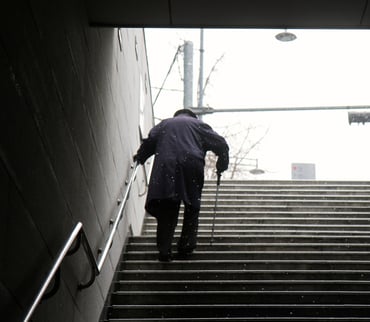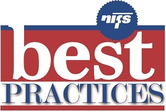 As you approach your later years in life, exercise and movement can help combat some of the unpleasant effects of aging. There are many ways that you can exercise your body, but as you get older, how do you know what kind of exercise is the best and safest? The short answer is it depends. There is not just one kind of exercise that is the best. In general, incorporating aerobic exercise, strength training, flexibility, and balance work into your exercise routine will give you the most well-rounded benefits. Having the knowledge of the benefits of each type of exercise can help you determine what to prioritize based on your own individual needs.
As you approach your later years in life, exercise and movement can help combat some of the unpleasant effects of aging. There are many ways that you can exercise your body, but as you get older, how do you know what kind of exercise is the best and safest? The short answer is it depends. There is not just one kind of exercise that is the best. In general, incorporating aerobic exercise, strength training, flexibility, and balance work into your exercise routine will give you the most well-rounded benefits. Having the knowledge of the benefits of each type of exercise can help you determine what to prioritize based on your own individual needs.
Effects of Aging
As we age, we all know that our bodies experience wear and tear. A decrease in muscle mass, balance, and flexibility are inevitable with age, regardless of how active you are. Muscles and bones become weaker, joints become stiffer, and overall functionality declines. After the age of 30, you start to lose 3% - 5% of your muscle mass every decade. This rate increases once you reach the age of 60. Luckily, there are ways that you can reduce this rate of decline.
Exercise Recommendations
The Center for Disease Control and Prevention recommends that adults 65 and older should aim to get at least 150 minutes of moderate aerobic activity every week. When you break it down, that’s only 30 minutes each day if you exercise 5 days in a week. This can be as simple as walking the dog, gardening, or playing catch with your grandkids. Older adults should strength train, stretch, and work on balance at least twice a week. Yoga is a great way to incorporate flexibility, core strength, and balance into your weekly routine. There are several different types of yoga, and this practice can be done seated or standing, so no matter your experience or ability level, anyone can participate.
It’s easy to overcomplicate or feel overwhelmed with these recommendations. If you are currently inactive, start with exercising just one or two days a week, then gradually increase. If 30 minutes all at once feels like too much, you can split up your exercise into 10-minute bouts throughout the day. Find an activity that you enjoy doing and stick with it. As long as you stay consistent, you will notice an increase in stamina over time. Building up stamina and strength will help you improve the overall quality and quantity of your life.
It may be beneficial to seek help from a fitness professional if you are unsure of where to start. A personal trainer can help tailor an exercise routine to fit your specific needs and goals. They can also ensure proper technique to reduce risk of injury and maximize benefits.
Benefits of Regular Exercise
The benefits of exercising regularly are plentiful! Let’s break down the specific benefits for each category of exercise.
Aerobic Exercise
- Improves heart health, lung function, and circulatory system
- Prevents illness and diseases
- Increases stamina
- Lowers blood pressure and heart rate
- Regulates blood sugar
- Improves sleep
- Weight management
- Improves mood and reduces stress
Strength Training
- Strengthens muscles
- Increases muscle mass
- Increases metabolism
- Reduces risk of falls
- Prevents osteopenia and osteoporosis
Balance
- Prevents falls
- Improves posture, coordination, and stability
- Reduces risk of injuries
- Improves quality of life
Flexibility
- Increases range of motion and mobility
- Prevents injuries
- Improves circulation
- Reduces pain
- Promotes relaxation
Building an Exercise Routine
Each individual body is unique and there is no one size fits all exercise routine that everyone needs to follow. There are several factors that may come into play when deciding what to prioritize, including age, medical conditions, current activity level, and personal preference. For example, someone with osteoporosis may want to focus on strength training and balance to increase bone density and decrease fall risk. While someone who has arthritis might want to prioritize stretching to improve joint flexibility. An individual with hypertension should probably work on aerobic exercise first to decrease blood pressure and heart rate.
Following a holistic approach to exercise by incorporating pieces of aerobic exercise, strength training, flexibility, and balance into your exercise routine is your best bet for staying fit and functional as you age. Using the CDC’s exercise recommendations as a guide can be helpful, however, you have the freedom to prioritize what you think is best for your own individual needs.


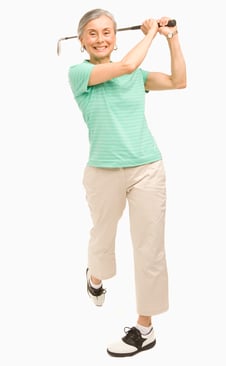 Most folks who have ever participated in balance training know that most exercises seem to involve only the legs. While it is important to focus on our lower extremities during our training, it is important to incorporate the use of our arms for more functional and effective training. Why? Because this will have more real-world applications! For example, practicing single leg stance is important for improving balance but most of us are not going to be in a situation where we must stand on one leg for an extended period of time. We will, however, be shifting our weight from one leg to another, swinging our arms like we do when walking, taking the stairs, dancing, or cleaning the house in real world daily activities.
Most folks who have ever participated in balance training know that most exercises seem to involve only the legs. While it is important to focus on our lower extremities during our training, it is important to incorporate the use of our arms for more functional and effective training. Why? Because this will have more real-world applications! For example, practicing single leg stance is important for improving balance but most of us are not going to be in a situation where we must stand on one leg for an extended period of time. We will, however, be shifting our weight from one leg to another, swinging our arms like we do when walking, taking the stairs, dancing, or cleaning the house in real world daily activities.
.jpg?width=300&name=GettyImages-1157822544%20(1).jpg) We hear a lot about stability, but how do you accurately incorporate it into a client’s program? Understanding how to incorporate stability training will help keep your clients functional, independent, and healthy regardless of age.
We hear a lot about stability, but how do you accurately incorporate it into a client’s program? Understanding how to incorporate stability training will help keep your clients functional, independent, and healthy regardless of age.
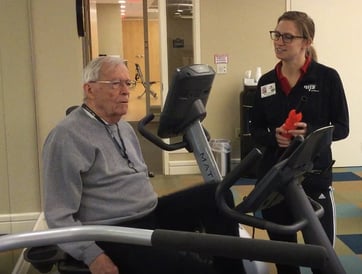 Fitness management is the cornerstone of our business. Recently we have seen an uptick in clients requesting our support in developing broader wellness programming for their residents through the continuums of care. Sometimes the need arises due to challenges with community personnel who don’t have the tools and resources to cultivate the desired lifestyle for residents. Sometimes it’s because they don’t have a point person to pull everyone together out of their silos across the continuums. Sometimes it’s both! Sound familiar?
Fitness management is the cornerstone of our business. Recently we have seen an uptick in clients requesting our support in developing broader wellness programming for their residents through the continuums of care. Sometimes the need arises due to challenges with community personnel who don’t have the tools and resources to cultivate the desired lifestyle for residents. Sometimes it’s because they don’t have a point person to pull everyone together out of their silos across the continuums. Sometimes it’s both! Sound familiar?
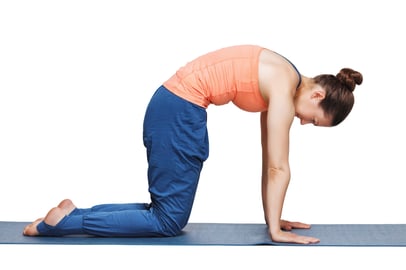 After a workout, it’s important to
After a workout, it’s important to 
